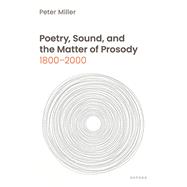Poetry, Sound, and the Matter of Prosody, 1800–2000
, by Miller, Peter- ISBN: 9780198937180 | 0198937180
- Cover: Hardcover
- Copyright: 6/13/2025
When modernist poets rejected meter at the beginning of the twentieth century, they seemed to reject something at the heart of poetry: sound. Yet meter was only one of the many sound media that poets on either side of 1900 used to structure their poems. As new technologies, such as the phonograph, unsettled printed modes of representing sound, language, and voice, poets likewise pluralized the sonic basis, or "prosody," of their work. Enlisting talking birds and printed ballads, illuminated manuscripts and books shaped like vinyl LPs, poets in Britain and America mixed new media with old to revitalize the lyric tradition and explore the cultural stakes of sound reproduction. Examining key moments of prosodic innovation from Romanticism to hip hop, Poetry, Sound, and the Matter of Prosody, 1800-2000 reads the fall of meter against the rise of modern sound technology to reframe prosodic analysis as a form of media theory. By considering the broad range of elements affecting the sounds and rhythms of poetic language, some tangible (e.g. paper, ink, vinyl), others intangible (e.g. meter, genre, musical form), Peter Miller provides a richer sense of the prosodic repertoire of individual poems while enabling unexpected connections between poems from different historical periods. Anchored around five canonical figures, William Wordsworth, Edgar Allan Poe, Emily Dickinson, Ezra Pound, and Langston Hughes, while attending to their work's ongoing transformation by contemporary popular culture, the book offers both formal and historical insights into the nature of lyric poetry after Romanticism.






